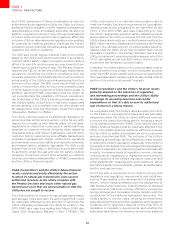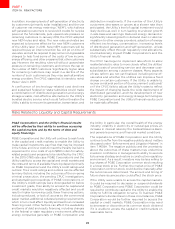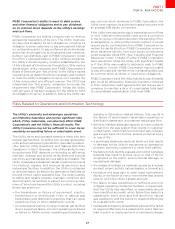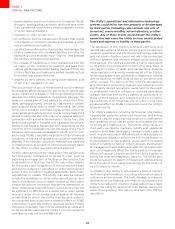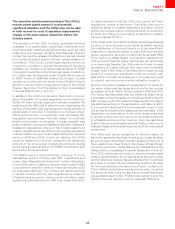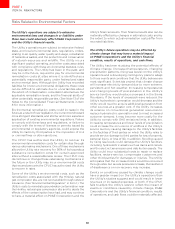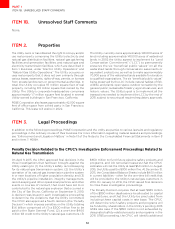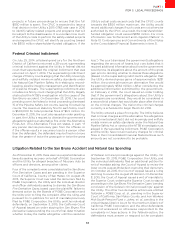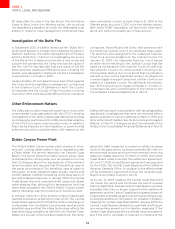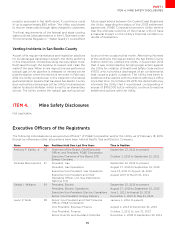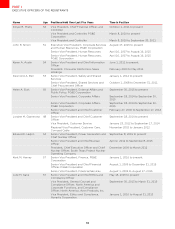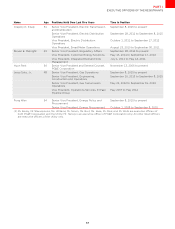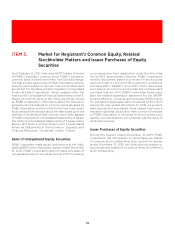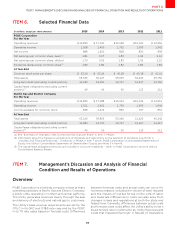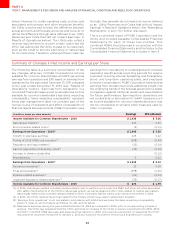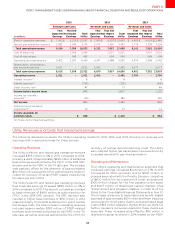PG&E 2015 Annual Report Download - page 42
Download and view the complete annual report
Please find page 42 of the 2015 PG&E annual report below. You can navigate through the pages in the report by either clicking on the pages listed below, or by using the keyword search tool below to find specific information within the annual report.
34
PART I
ITEM 3.LEGAL PROCEEDINGS
30 days after the stay in the San Bruno Fire Derivative
Cases is lifted. In the Iron Workers action, the court has
not established a deadline by which the defendants must
answer or respond. Case management conferences have
been scheduled in both actions (March 21, 2016 in the
Tellardin action and June 3, 2016 in the Iron Workers action),
after which PG&E Corporation will have more information
about any further proceedings in these actions.
Investigation of the Butte Fire
In September 2015, a wildfire (known as the “Butte fire”)
ignited and spread in Amador and Calaveras Counties in
Northern California. The California Department of Forestry
and Fire Protection (“Cal Fire”) is investigating the source
of the Butte Fire to determine whether a tree contacted
a power line operated by the Utility and was the cause of
the fire. Cal Fire has reported that as a result of the fire
there were two deaths and 965 structures, including 571
houses, were damaged or destroyed. Cal Fire’s investigation
is expected to conclude in 2016.
Approximately 27 complaints have been filed against
the Utility and its vegetation management contractors
in the Superior Court of California in both the County
of Calaveras and the County of San Francisco, involving
more than 600 individual plaintis and their insurance
companies. Plaintis and the Utility filed petitions with
the California Judicial Council to coordinate these cases.
The petitions were assigned to the Calaveras Superior
Court for a recommendation to the Judicial Council. On
January 21, 2016, the Calaveras Superior Court issued
an order recommending to the Judicial Council that the
cases be coordinated in the Superior Court of California,
Sacramento County, for all purposes including trial.
Among other factors, the Court found that coordination
requires a court with a significant number of judges and
complex litigation support personnel, neither of which are
present in Calaveras County. For additional information,
see “Enforcement and Litigation Matters” in Note 13:
Contingencies and Commitments of the Notes to the
Consolidated Financial Statements in Item 8.
Other Enforcement Matters
The Utility also could be required to pay fines, or incur other
unrecoverable costs, associated with the CPUC’s pending
investigations of the Utility’s natural gas distribution facilities
record-keeping practices and the Utility’s potential violations
of the CPUC’s ex parte communication rules. In addition,
fines may be imposed, or other regulatory or governmental
enforcement action could be taken, with respect to the
Utility’s self-reports of noncompliance with natural gas safety
regulations, investigations that were commenced after a
pipeline explosion in Carmel, California on March 3, 2014, and
other enforcement matters. See “Enforcement and Litigation
Matters” in Note 13: Contingencies and Commitments of the
Notes to the Consolidated Financial Statements in Item 8.
Diablo Canyon Power Plant
The Utility’s Diablo Canyon power plant employs a “once-
through” cooling water system that is regulated under
a Clean Water Act permit issued by the Central Coast
Board. This permit allows the Diablo Canyon power plant
to discharge the cooling water at a temperature no more
than 22 degrees above the temperature of the ambient
receiving water, and requires that the beneficial uses of
the water be protected. The beneficial uses of water in
this region include industrial water supply, marine and
wildlife habitat, shellfish harvesting, and preservation of
rare and endangered species. In January2000, the Central
Coast Board issued a proposed draft cease and desist
order alleging that, although the temperature limit has
never been exceeded, the Utility’s Diablo Canyon power
plant’s discharge was not protective of beneficial uses.
In October2000, the Utility and the Central Coast Board
reached a tentative settlement under which the Central
Coast Board agreed to find that the Utility’s discharge of
cooling water from the Diablo Canyon power plant protects
beneficial uses and that the intake technology reflects the
best technology available, as defined in the federal Clean
Water Act. As part of the tentative settlement, the Utility
agreed to take measures to preserve certain acreage
north of the plant and to fund approximately $6million in
environmental projects and future environmental monitoring
related to coastal resources. On March21, 2003, the Central
Coast Board voted to accept the settlement agreement.
On June17, 2003, the settlement agreement was executed
by the Utility, the Central Coast Board and the California
Attorney General’s Oce. A condition to the eectiveness
of the settlement agreement is that the Central Coast
Board renew Diablo Canyon’s permit.
At its July10, 2003 meeting, the Central Coast Board did
not renew the permit and continued the permit renewal
hearing indefinitely. Several Central Coast Board members
indicated that they no longer supported the settlement
agreement, and the Central Coast Board requested a team of
independent scientists, as part of a technical working group,
to develop additional information on possible mitigation
measures for Central Coast Board sta. In January2005, the
Central Coast Board published the scientists’ draft report
recommending several such mitigation measures. If the
Central Coast Board adopts the scientists’ recommendations,
and if the Utility ultimately is required to implement the


